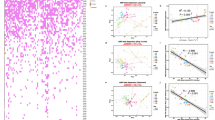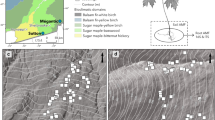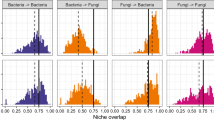Abstract
Most attempts to identify the processes that structure natural communities have focused on conspicuous macroorganisms whereas the processes responsible for structuring microbial communities remain relatively unknown. Two main theories explaining these processes have emerged; niche theory, which highlights the importance of deterministic processes, and neutral theory, which focuses on stochastic processes. We examined whether neutral or niche-based mechanisms best explain the composition and structure of communities of a functionally important soil microbe, the arbuscular mycorrhizal (AM) fungi. Using molecular techniques, we surveyed AM fungi from 425 individual plants of 28 plant species along a soil pH gradient. There was evidence that both niche and neutral processes structured this community. Species abundances fitted the zero-sum multinomial distribution and there was evidence of dispersal limitation, both indicators of neutral processes. However, we found stronger support that niche differentiation based on abiotic soil factors, primarily pH, was structuring the AM fungal community. Host plant species affected AM fungal community composition negligibly compared to soil pH. We conclude that although niche partitioning was the primary mechanism regulating the composition and diversity of natural AM fungal communities, these communities are also influenced by stochastic-neutral processes. This study represents one of the most comprehensive investigations of community-level processes acting on soil microbes; revealing a community that although influenced by stochastic processes, still responded in a predictable manner to a major abiotic niche axis, soil pH. The strong response to environmental factors of this community highlights the susceptibility of soil microbes to environmental change.
Similar content being viewed by others
Log in or create a free account to read this content
Gain free access to this article, as well as selected content from this journal and more on nature.com
or
References
Alonso D, Etienne RS, McKane AJ . (2006). The merits of neutral theory. Trends Ecol Evol 21: 451–457.
Altschul SF, Gish W, Miller W, Myers EW, Lipman DJ . (1990). Basic Local Alignment Search Tool. J Mol Biol 215: 403–410.
van Aarle IM, Olsson PA, Soderstrom B . (2002). Arbuscular mycorrhizal fungi respond to the substrate pH of their extraradical mycelium by altered growth and root colonization. New Phytol 155: 173–182.
Chave J . (2004). Neutral theory and community ecology. Ecol Lett 7: 241–253.
Chave J, Alonso D, Etienne RS . (2006). Theoretical biology: comparing models of species abundance. Nature 441: E1 Arising from: I Volkov, JR Banavar, F He, SP Hubell & Maritan A. Nature 438: 658–661 (2005).
Culman SW, Gauch HG, Blackwood CB, Thies JE . (2008). Analysis of T-RFLP data using analysis of variance and ordination methods: a comparative study. J Microbiol Meth 75: 55–63.
Dickie IA, FitzJohn RG . (2007). Using terminal restriction fragment length polymorphism (T-RFLP) to identify mycorrhizal fungi: a methods review. Mycorrhiza 17: 259–270.
Etienne RS . (2005). A new sampling formula for neutral biodiversity. Ecol Lett 8: 253–260.
Fitter AH . (2005). Darkness visible: reflections on underground ecology. J Ecol 93: 231–243.
Fitzsimons MS, Miller RM, Jastrow JD . (2008). Scale-dependent niche axes of arbuscular mycorrhizal fungi. Oecologia 158: 117–127.
Helgason T, Daniell TJ, Husband R, Fitter AH, Young JPW . (1998). Ploughing up the wood-wide web? Nature 394: 431.
Helgason T, Merryweather JW, Denison J, Wilson P, Young JPW, Fitter AH . (2002). Selectivity and functional diversity in arbuscular mycorrhizas of co-occurring fungi and plants from a temperate deciduous woodland. J Ecol 90: 371–384.
Helgason T, Merryweather JW, Young JPW, Fitter AH . (2007). Specificity and resilience in the arbuscular mycorrhizal fungi of a natural woodland community. J Ecol 95: 623–630.
Hubbell SP . (2001). The Unified Neutral Theory of Biodiversity and Biogeography. Monographs in Population Biology 32. Princeton University Press: Princeton, USA.
Hughes JB, Hellmann JJ, Ricketts TH, Bohannan BJM . (2001). Counting the uncountable: statistical approaches to estimating microbial diversity. Appl Environ Microb 67: 4399–4406.
Jongman RHG, Ter Braak CJF, Van Tongeren OFR . (1995). Data Analysis in Community and Landscape Ecology. Cambridge University Press: Cambridge, UK.
Kanagawa T . (2003). Bias and artifacts in multitemplate polymerase chain reaction (PCR). J Biosci Bioeng 96: 317–323.
Lee JA . (1999). The calcicole-calcifuge problem revisited. Adv Bot Res 29: 1–30.
Legendre P, Borcard D, Peres-Neto PR . (2005). Analyzing beta diversity: partitioning the spatial variation of community composition data. Ecol Monogr 75: 435–450.
Legendre P, Mi X, Ren H, Ma K, Yu M, Sun IF et al. (2009). Partitioning beta diversity in a subtropical broad-leaved forest of China. Ecology 90: 663–674.
Leibold MA, McPeek MA . (2006). Coexistence of the niche and neutral perspectives in community ecology. Ecology 87: 1399–1410.
Lekberg Y, Koide RT, Rohr JR, Aldrich-Wolfe L, Morton JB . (2007). Role of niche restrictions and dispersal in the composition of arbuscular mycorrhizal fungal communities. J Ecol 95: 95–105.
Lueders T, Friedrich MW . (2003). Evaluation of PCR amplification bias by terminal restriction fragment polymorphism analysis of the small-subunit rRNA and mcrA genes by using defined template mixtures of methanogenic pure cultures and soil DNA extracts. Appl Environ Microb 69: 320–326.
Liu Y, He L, An LZ, Helgason T, Feng HY . (2009). Arbuscular mycorrhizal dynamics in a chronosequence of Caragana korshinskii plantations. Fems Microbiol Ecol 67: 81–92.
Magurran AE . (2004). Measuring Biological Diversity. Blackwell: Oxford, UK.
McGill BJ, Maurer BA, Weiser MD . (2006). Empirical evaluation of neutral theory. Ecology 87: 1411–1423.
Merryweather J, Fitter AH . (1998). The arbuscular mycorrhizal fungi of Hyacinthoides non-scripta—I Diversity of fungal taxa. New Phytol 138: 117–129.
Olszewski TD, Erwin DH . (2004). Dynamic response of Permian brachiopod communities to long-term environmental change. Nature 428: 738–741.
Öpik M, Moora M, Liira J, Zobel M . (2006). Composition of root-colonizing arbuscular mycorrhizal fungal communities in different ecosystems around the globe. J Ecol 94: 778–790.
Osborn AM, Moore ERB, Timmis KN . (2000). An evaluation of terminal-restriction fragment length polymorphism (T-RFLP) analysis for the study of microbial community structure and dynamics. Environ Microbiol 2: 39–50.
Preston FW . (1948). The commonness, and rarity, of species. Ecology 29: 254–283.
R Development Core Team (2007). R: A Language and Environment for Statistical Computing. R Foundation For Statistical Computing: Vienna, Austria (http://www.R-project.org).
Rosendahl S . (2008). Communities, populations and individuals of arbuscular mycorrhizal fungi. New Phytol 178: 253–266.
Santos JC, Finlay RD, Tehler A . (2006). Molecular analysis of arbuscular mycorrhizal fungi colonising a semi-natural grassland along a fertilisation gradient. New Phytol 172: 159–168.
Schechter SP, Bruns TD . (2008). Serpentine and non-serpentine ecotypes of Collinsia sparsiflora associate with distinct arbuscular mycorrhizal fungal assemblages. Mol Ecol 17: 3198–3210.
Simon L, Lalonde M, Bruns TD . (1992). Specific amplification of 18S fungal ribosomal genes from vesicular-arbuscular endomycorrhizal fungi colonizing roots. Appl Environ Microb 58: 291–295.
Singh BK, Nunan N, Ridgway KP, McNicol J, Young JPW, Daniell TJ et al. (2008). Relationship between assemblages of mycorrhizal fungi and bacteria on grass roots. Environ Microb 10: 534–541.
Smith SE, Read DJ . (2008). Mycorrhizal Symbiosis, 3rd edn. Academic Press: San Diego, USA.
Taberlet P, Gielly L, Pautou G, Bouvet J . (1991). Universal primers for amplification of 3 noncoding regions of chloroplast DNA. Plant Mol Biol 17: 1105–1109.
Tokeshi M . (1990). Niche apportionment or random assortment—species abundance patterns revisited. J Anim Ecol 59: 1129–1146.
Tuomisto H, Ruokolainen K . (2006). Analyzing or explaining beta diversity? Understanding the targets of different methods of analysis. Ecology 87: 2697–2708.
Vandenkoornhuyse P, Ridgway KP, Watson IJ, Fitter AH, Young JPW . (2003). Co-existing grass species have distinctive arbuscular mycorrhizal communities. Mol Ecol 12: 3085–3095.
Volkov I, Banavar JR, He F, Hubbell SP, Martin A . (2005). Density dependence explains tree species abundance and diversity in tropical forests. Nature 438: 658–661.
Williamson M, Gaston KJ . (2005). The lognormal distribution is not an appropriate null hypothesis for the species-abundance distribution. J Anim Ecol 74: 409–422.
Acknowledgements
We thank Natural England and the Yorkshire Wildlife Trust for permission to work at Hetchell Wood, and Naveed Aziz and Celina Whalley of the University of York Genomics Facility for technical advice and assistance. This study was funded by a Natural Environment Research Council (http://www.nerc.ac.uk/) Grant (NE/D01090X/1).
Author information
Authors and Affiliations
Corresponding author
Additional information
Supplementary Information accompanies the paper on The ISME Journal website (http://www.nature.com/ismej)
Rights and permissions
About this article
Cite this article
Dumbrell, A., Nelson, M., Helgason, T. et al. Relative roles of niche and neutral processes in structuring a soil microbial community. ISME J 4, 337–345 (2010). https://doi.org/10.1038/ismej.2009.122
Received:
Revised:
Accepted:
Published:
Issue date:
DOI: https://doi.org/10.1038/ismej.2009.122
Keywords
This article is cited by
-
Facultative mycorrhization in a fern (Struthiopteris spicant L. Weiss) is bound to light intensity
BMC Plant Biology (2024)
-
Plant effects on microbiome composition are constrained by environmental conditions in a successional grassland
Environmental Microbiome (2024)
-
Plasmids in the human gut reveal neutral dispersal and recombination that is overpowered by inflammatory diseases
Nature Communications (2024)
-
Nitrogen deposition mediates more stochastic processes in structuring plant community than soil microbial community in the Eurasian steppe
Science China Life Sciences (2024)
-
Rhizosphere fungal community assembly varied across functional guilds in a temperate forest
Ecological Processes (2023)



